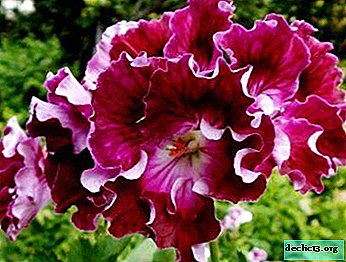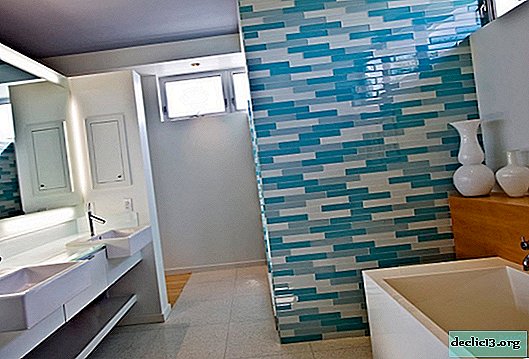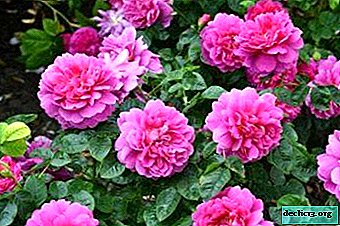Charming cactus echinopsis - its main types, care and reproduction instructions
 Echinopsis is grown as an independent flower, and is also used in various floral arrangements. The flowers of these cacti do not leave anyone indifferent, and the unpretentiousness and ease of care make plants permanent residents of houses.
Echinopsis is grown as an independent flower, and is also used in various floral arrangements. The flowers of these cacti do not leave anyone indifferent, and the unpretentiousness and ease of care make plants permanent residents of houses.
In our article, we will consider all the nuances of maintaining the home of this beautiful succulent. Let's talk about its main types. We discuss the features of reproduction and possible problems with its cultivation. You can also watch an interesting and useful video on this topic.
Botanical Description and Geography
Attention: Echinopsis belongs to the cactus family. Its name is composed of two Greek words: echinus (hedgehog) and opsis (similar), because the young plant resembles a hedgehog curled into a ball.Young echinopsis look like spiky balls of light green or dark green. With age, the stem lengthens and acquires a columnar shape. The root system is powerful, but shallow, growing to the sides.
Areoles are at the same distance from each other. Rigid spines grow from them. Buds emerge from the lateral areoles in the middle of the cactus.
Echinopsis in nature is common in Latin America: from northern Bolivia to southern Argentina, southern Brazil and Uruguay. Echinopsis grow in the foothills and valleys of the Andes.
The main types and their photos
Echinopsis is popular among lovers of cacti, due to the unpretentiousness of the plant and the chic flowers that it produces with proper care.
Echinopsis oxigona

Cactus with a green spherical stem, growing from 5 to 25 cm in diameter. It has 8-14 rounded ribs, sometimes bumpy. Areles of a whitish hue, slightly recessed, with spines. Cactus flowers white or pink, up to 22 cm long.
We recommend watching the video about the echinopsis Oxigona:
Eyriesii

A plant with a dark green stem having 11-18 ribs. Sharp awl-shaped spines grow from areoles. The flowers are long - up to 25 cm, white or light pink, rarely a darker strip passes in the center of the petal.
Tubiflora

Echinopsis with a green stem, at a young age has a spherical shape, is gradually extended into a cylindrical. Ribs 11-12 pieces with deep grooves. Areoles are painted white, gray or black; spines are yellow with dark brown tips. Funnel-shaped flowers, up to 25 cm long, 10 cm in diameter.
In more detail about the most popular types of Echinopsis we described in a separate material.
Briefly about leaving
Cactus prefers long daylight hours. The plant should be accustomed to direct sunlight gradually so that it does not receive burns. It is necessary to cover the cactus from the midday sun and periodically spray it.
Echinopsis tolerates the heat steadily, but from mid-autumn the air temperature should be gradually reduced to 6-10 degrees. Such conditions will enable the plant to relax and form flower buds.
Even in the hot season, cactus is enough to water 1-2 times a week. In winter, the soil should be moistened once a month.
Tip: During the period of active growth and flowering, echinopsis must be fed with complex fertilizers for cacti on average once a month.Echinopsis is planted in shallow and wide containers. Transplantation is carried out every 2-4 years. During the transshipment of plants, it is advisable to preserve the old earthen lump, so as not to damage the roots. The soil should consist of gravel, sand and large abrasive materials - it can be brick chips, gravel, perlite. After transplanting, the cactus is not watered for a week.
We recommend watching a video about caring for an echinopsis cactus:
Propagation of domestic cactus
Echinopsis propagates by seeds and children, which grow on the sides of an adult plant.
Cactus seeds are sown in spring in moist soil.which consists of:
- sand (1 part);
- charcoal (1.2 parts);
- sheet land (1 part).
 Before sowing, the seeds are soaked for a couple of hours in a solution of warm water. A container with seedlings is covered with a film, which is periodically removed to ventilate and moisten the soil. The air temperature should be 17-20 degrees. After 15-20 days, the first shoots appear.
Before sowing, the seeds are soaked for a couple of hours in a solution of warm water. A container with seedlings is covered with a film, which is periodically removed to ventilate and moisten the soil. The air temperature should be 17-20 degrees. After 15-20 days, the first shoots appear.
When propagated by children, they are separated from the adult plants, dried for several days and planted in slightly moistened sand. Doing it better in the spring. After 1-2 weeks, the "children" take root and they can be transplanted into the ground for adult plants.
If echinopsis is already old, then it can be rejuvenated. For this, the top of the stem is carefully cut. 10-12 days it is dried and planted in wet sand for rooting. The remaining hemp should also appear young shoots.
In the open ground
Cacti of the genus Echinopsis feel great on verandas or in the open ground. They love fresh air and lots of light. Echinopsis is much easier than other cacti to tolerate heavy and nutritious soil. Despite the fact that cactus is a rather heat-loving culture and for its favorable growth it is necessary to create certain conditions, some species grow in open ground. It is best to plant cacti in open ground in rocky areas, for example, on alpine hills. For echinopsis, it is better to choose a sunny place, protected from the north wind.
A slide for cacti should consist of:
- from large stones;
- fine gravel;
- broken brick;
- coarse sand;
- fertile soil;
- wood ash;
- peat.
It’s better to plant cacti on a hill in warm spring weather in the second half of May. At first, the planted cacti are covered with a film, since in the spring frosts are still possible. It should be planted in slightly moist soil and not watered for a week. Under the stems of large specimens, you can add drainage from fine gravel to strengthen them more tightly.
It is advisable to fill the areas between the stems of plants with colored rubble or small pebbles so that raindrops do not erode the soil and do not spray dirt on the cacti.
The first time cacti must be shaded so that they do not get burns. After rooting, the film is removed, and the plants no longer need additional shade. With the onset of cold weather, cacti should be relocated to a cool room for wintering.
Bloom
 Echinopsis blooms in spring and blooms until the end of summer. In the upper part around the plant’s circumference, buds grow on long stems, which turn into beautiful funnel-shaped flowers with a diameter of 15 cm. The stalk looks like a spiny tubular process 20 cm long.
Echinopsis blooms in spring and blooms until the end of summer. In the upper part around the plant’s circumference, buds grow on long stems, which turn into beautiful funnel-shaped flowers with a diameter of 15 cm. The stalk looks like a spiny tubular process 20 cm long.
The corolla consists of several rows of petals and can be painted white, pink, yellow, orange and red. Some types of echinopsis exude a delicate aroma. In the genus, you can find views with night and day flowers. The number of flowers depends on the age of the cactus. Mature specimens can produce up to 25 buds at the same time!
The life span of the echinopsis flower is short - only 1-3 days, depending on the ambient temperature. After flowering, oblong-shaped fruits with juicy pulp appear on the legs, inside of which black seeds ripen.
What if buds are not formed?
If echinopsis does not bloom, then perhaps favorable conditions have not been created for it. Cactus flowering can be expected under the following conditions:
- provide a cool and dry wintering at a temperature of 5-10 degrees;
- start abundant watering only after the first buds appear;
- take out in the summer in the open air;
- from March to September to feed fertilizers for cacti;
- in time to separate the children, leaving no more than two;
- in spring and summer, do not turn the pot and do not move it from place to place.
If a cactus is grown from a baby of a non-blooming echinopsis, then it produces buds for a very long time and reluctantly.
We recommend watching a video on how to make Echinopsis blossom:
Diseases and Pests
Echinopsis, like many succulents, is resistant to various pests and diseases. With frequent watering, a fungal disease can develop. In this case, the soil should be completely replaced, the roots treated with a fungicide and reduce the amount of watering.
Of the pests, you can find a mealybug or spider mite, which can be easily managed using insecticides.
Similar plants
The structure of the flower echinopsis is similar to lobivia and mamillaria, only the flowers of these specimens grow on short stems. By the structure of the stem, the young specimen resembles a notocactus. An adult, oblong, echinopsis is similar to parody and cereus, but the latter has fewer ribs.
Conclusion
Samples of the genus Echinopsis are the most popular and common cacti among lovers of prickly plants. In Europe, this genus has been grown since about 1700. There are a large number of hybrids of various shades. With proper care, the cactus regularly pampers its owners with chic flowers.

















